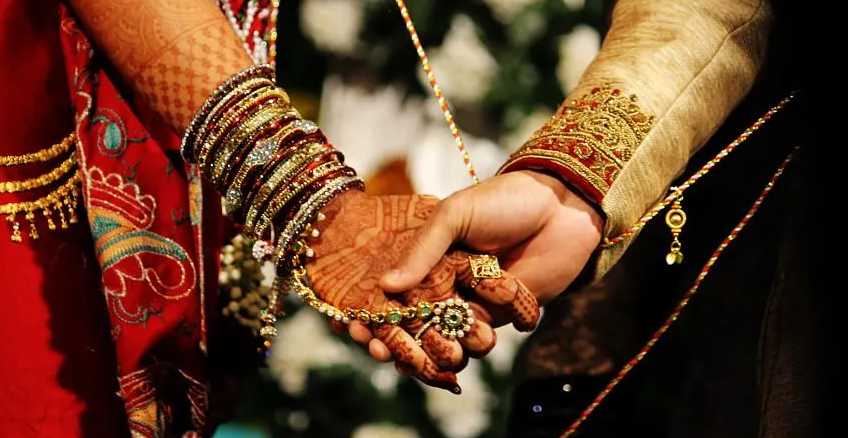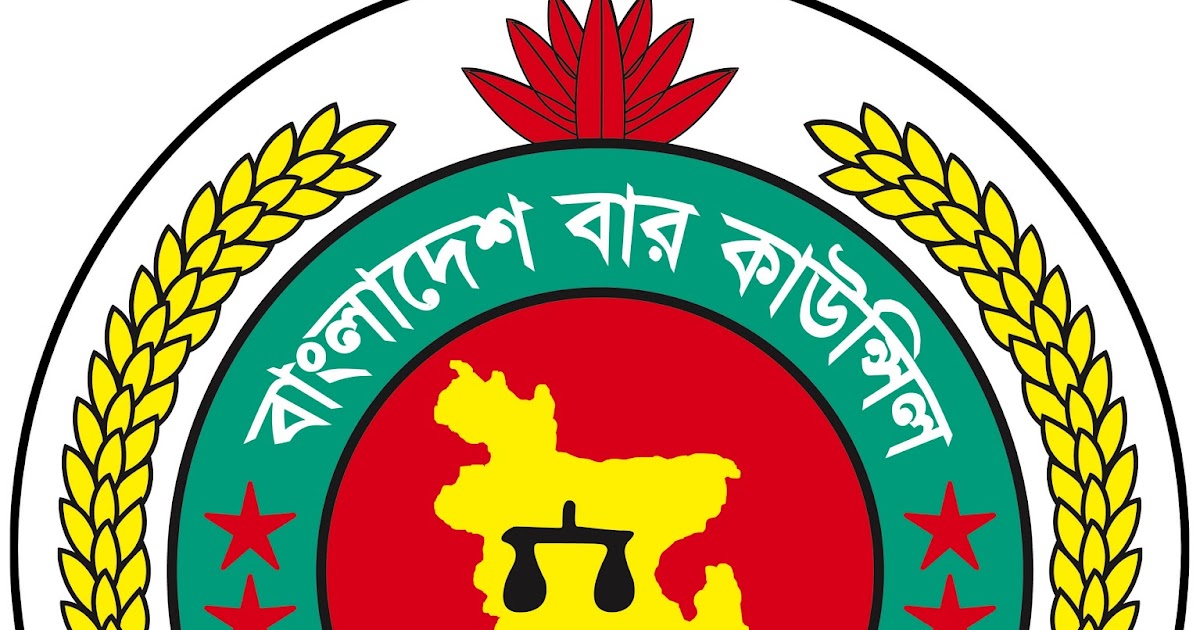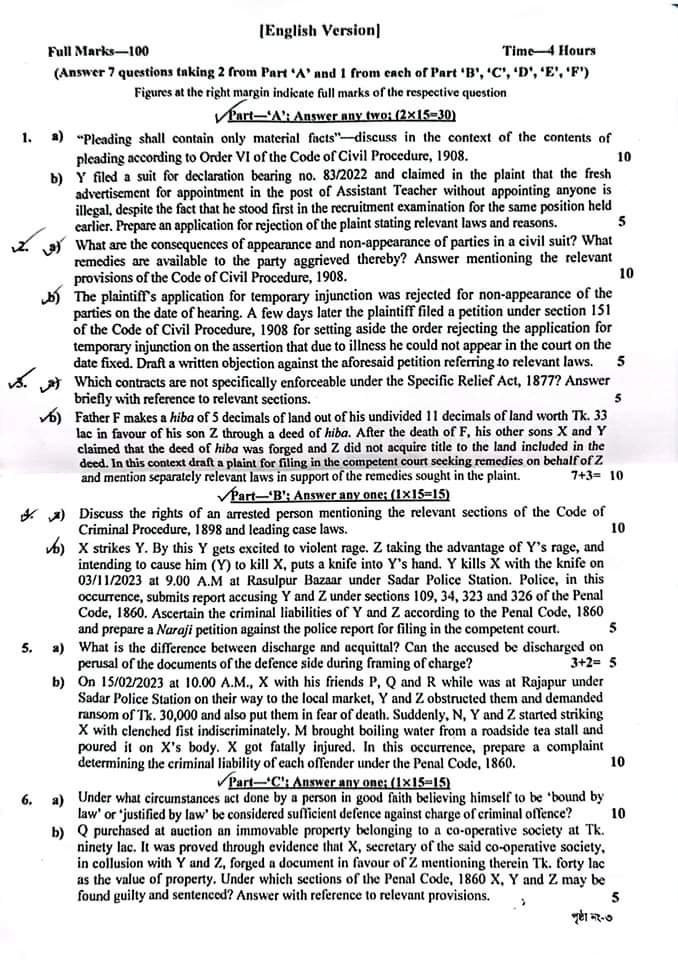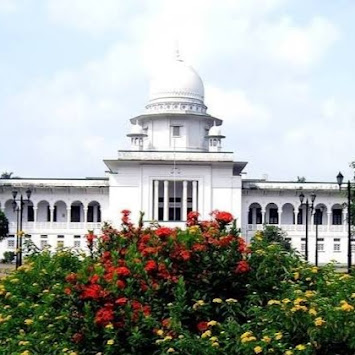Hindu Marriage and related issues under Hindu Law in Bangladesh
According to Vedas-
“a man is complete and is capable of performing a sacrifice only after obtaining a wife and having a son.”
Marriage among the Hindus was believed to be a most important samskara or life cycle ritual in a Hindu‟s life that aimed to bind the parties to a marriage with an indissoluble bond which continues even in the next world. In ancient times, Hindu marriage had three chief objectives, namely-
– religious duty (dharma),
– procreation of children (praja) a
– and conjugal life (rati).
Hindu Marriage is sacrament: Hindu marriage is not considered as a contract rather it is sacrament. Hindu marriage is
“a religious sacrament in which a man and a woman are bound in a permanent relationship for the physical, social and spiritual need of dharma, procreation and sexual pleasure.”
In accordance with the ancient and Bangladeshi Hindu law, Hindu marriage is a sacrament and it is the last of the ten sacraments for men and perhaps the only sacrament for females. So a Hindu marriage cannot be regarded as a contract, as there is no dissolution of Hindu marriage. We know that the important element of a contract is that the parties must have attained the age of majority and make agreement between themselves. But this is not the case in a Shastric Hindu marriage.
Forms of Hindu
marriage: The ancient Hindu law recognized eight forms of marriage, of
which four were approved and four unapproved. The approved forms were Brahma,
Daiva, Arsha and Prajapatya. The unapproved forms were Asura, Gandharva,
Rakshasa and Paishacha.
|
Approved
Forms of Hindu Marriage |
||
|
SL |
Form |
Details |
|
01 |
Brahma marriage |
In this form of marriage the girl, decorated with clothes and ornaments, is given in marriage by the guardians to a learned and gentle bridegroom. In Brahma form of marriage the father and other guardians of the bride give her in marriage without receiving any consideration from the bridegroom. This is the most prevalent form of marriage in present Hindu society in Bangladesh. |
|
02 |
Prajapatya marriage |
In this form of marriage the daughter is offered to the bride-groom by blessing them with the enjoyment of marital bliss and the fulfilment of dharma. |
|
03 |
Aarsh marriage |
In this form of marriage a rishi used to accept a girl in marriage after giving a cow or bull and some clothes to the parents of the girl. According to P.K.Acharya the word aarsh has been derived from the word rishi. |
|
04 |
Daiva Marriage |
In this form of marriage the girl, decorated with ornaments and clothes, was offered to the person who conducted the function of a Purohit in yajna. |
|
Unapproved
Forms of Hindu Marriage |
||
|
SL |
Form |
Details |
|
05 |
Asura marriage |
In this form of marriage the bride-groom gets the bride in exchange of some money or articles given to the family members of the bride. |
|
06 |
Gandharva marriage |
This form is marriage is the result of mutual affection and love of the bride and the bride-groom. |
|
07 |
Rakshas marriage: |
This type of marriage was prevalent in the age when women were considered to be the prize of the war. In this type of marriage the bride-groom takes away the bride from her house forcibly after killing and injuring her relatives. |
|
08 |
Paisach marriage: |
In this type a man enters into sexual relationship with a sleeping, drunk or unconscious woman. Such acts were regularised after the performance of marriage ceremony which took place after physical relationship between the man and woman. |
Essential Conditions of a Valid Hindu Marriage: Under the textual Hindu law, three conditions are considered essential for the validity of marriage. These conditions include:
1. identity of caste;
2. parties have to be beyond the prohibited degrees of relationship, i.e. not of the same „gotra‟ or „pravara‟ and not the „sapinda‟ of each other; and
3. the proper performance of ceremonies of marriage.
Identity of caste: During the ancient Vedic period, society was not divided into classes or Cactes and there was no prohibition to their interrelationship. Later, the caste system came into existence to classify Hindus on the basis of profession, and in turns, many social contacts and mutual relationships, including inter caste marriage, got prohibited.
Manu recognized caste system by the
following words:
“marriage between parties of the same caste. Although „Anuloma‟ marriage was permitted and recognized, the „Pratiloma‟ marriage was prohibited
Presently, “The Hindus of Bangladesh now do not strictly follow the pattern set by their religion on the basis of professional activities. The reality of present Bangladesh is that inter-caste marriages are taking place and are often solemnized by the priests. Unlike the old practice where the guardians of the parties to a marriage used to arrange the same, new generations are choosing their own partners and such marriages are being accepted generally as long as the marriages are within the broad range of Hindu religion. (Shahnaz Huda, „Combating Gender Justice: Hindu law in Bangladesh‟, 2011)
On the other hand, in India after the passing of the Hindu Marriage Act, 1955 the division of Hindus into four castes has been obsolete. Now in India identity of caste or sub caste for marriage is not necessary and inter caste marriage is allowed.
Section 29(2) of the Act of 1955 declares that marriage solemnized before the commencement of the said Act, shall not be deemed to be invalid by reason only of the fact that the parties thereto belonged to different castes or divisions of the same caste.
Parties to be beyond prohibited degrees: It
is found in the text of Vishnu that one should not marry a wife belonging to
the same gotra or pravara. Moreover, they should not be “Sapindas‟. It is also
thought by some that marriage under Hindu law is restricted to a large number
of near relatives for the purpose of retention of joint family system which is
usually the normal condition of Hindu society. Under Hindu law there are two
rules as regards the prohibited degrees which are as follows:
1.A man can‟t marry a girl of same gotra or
pravar.
According to Dayabagha School, a man cannot
marry a girl
a. if she is within seventh degree in descent from his father or fromone of his father‟s six ancestors in the male line.
b. if she is within the fifth degree in descent from his maternal grandfather or from one of his maternal grandfather’s four ancestors in the male line.
c. if she is within seventh degree in descent from his father‟s Bandus from one of their six ancestors through whom the girl is related to him.
d. if she is within fifth degree in descent from his mother‟s three technical Bandus or from one of their four ancestors through whom the girl is related to him.
According to
Mitakshara School:
A man cannot marry a girl
a. if their common ancestor being traced through his or her father, is not beyond the seventh in the line of ascent from him or her and
b. if their common ancestor being traced through their mother, is not beyond the fifth in the line of ascent from her.
c. a man can‟t marry a girl who is sapinda and two schools are agreed with this. But there is a difference between two schools as to who are sapindas for marriage:
According to Dayabagha or Bengal School:
A man can‟t marry a girl-
a. if she is within seventh degree in descent from his father or from one of his father‟s six ancestors in the male line.
b. if she is within fifth degree in descent from his maternal grandfather or from one of his maternal grandfather‟s four ancestors in the male line.
c. if she is within seventh degree in descent from his father‟s three technical Bandus or from one of their six ancestors through whom the girl is related to him.
d. if she is within fifth degree in descent from his mother‟s three technical Bandus or from one of their four ancestors through whom the girl is related to him.
A girl though related within the degrees mentioned above may be taken in marriage if she is removed by three gotras from him.
According to Mitakshara School,
A man cannot marry a girl
a. if their common ancestor, being traced through his or her father is not beyond the seventh in the line of ascent from him or her, or
b. if their common ancestor being traced through their mothers, is not beyond the fifth in the line of ascent from him or her.
The Hindu Marriage Disabilities Removal Act 1946 has paved the way for marriage between the Hindus belonging to same gotra or pravara, as section 2 of the Act provides that
“notwithstanding any text, rule or interpretation of the Hindu Law or any custom or usage, a marriage between Hindus, which is otherwise valid, shall not be invalid by reason only of the fact that the parties thereto; (a) Belong to the same gotra or pravara”
But in India after the passing of the “Hindu Marriage Act,1955” the difference between these two schools as regards the prohibited degrees of relationship for the purpose of marriage is abolished. This Act curtails the ancient degrees of prohibited relationship and sapinda relationship and prescribes the aforesaid four types of prohibited degrees of relationship and also enacts (aforesaid) sapinda relationship.
Marital Ceremonies: Another
essential of a Hindu marriage in Bangladesh is that the prescribed ceremonies have to be performed. Traditional Hindu marriage was completed and celebrated by
different ceremonies. These may
include two main ceremoniesa. Viva homa, i.e., invocation before the sacred
fire and b. Saptapadi, i.e., the
taking of the seven steps before the sacred
fire by the bride and the bridegroom.
But, these ceremonies may vary locality to locality or caste to caste. In addition, the marriage of virgins
and widows followed different rituals.
Some of these ceremonies were religious and others were merely cultural. The religious ceremonies were essential for the validity of the marriage. Proper
observance of these ceremonies had the
effect of legalizing the marriage, legitimizing children and getting
recognition of people.
Following two cases
can make us clear-
In Utpal Kanti Das Vs Monju Rani Das (50DLR AD 1998 47) both parties belonged to the Shusdra caste of the Hindu community. Monju claimed they married at a Hindu temple according to the Hindu Shastra in the presence of several persons and then later swore an affidavit together before a First class Magistrate confirming the marriage. However, Utpal later abandoned her and remarried, after she refused to accede to dowry demands. Monju claimed maintenance in the Family Court. Utpal denied being married to Monju.
Observation of the Court: The Court Held It has been contested that the marriage is bad in law because the two essential ceremonies of Hindu marriage, namely, a) saptapadi and b) invocation before the sacred fire had not been performed. But, In the above case, both husband and wife belonged to the Sudra caste of the Hindu community. Their marriage was celebrated in a Kali temple before a deity and was followed by a number of ceremonies, including the exchange of garlands, which are sufficient to constitute a valid marriage among the Sudras by custom.” Accordingly, the marriage is valid.
In Amulya Chandra Modak Vs State (35 DLR 1983 160) the appellant, Amulya Chandra Modak, asked a young female neighbor to live at his house to look after his ailing mother. Without his parent‟s knowledge, he promised to marry her ceremonially at a later stage and started cohabiting with her. When she became pregnant and his parents refused to approve of their marriage, he refused to marry her. The woman‟s father filed a complaint with the Magistrate and Amulya was convicted under Section 493 Penal Code. He appealed denying the marriage.
The court observed
that-
“invocation before the sacred fire and saptapadi, that is the taking of seven steps by the bridegroom and the bride jointly before the sacred fire, are the two essential ceremonies required for the validity of a Hindu marriage either in the Brahma form or in the Asura form.”
The above marriage is bad at law and not valid one. Unless any recognized customary marital ceremony is present at the society the above two marital ceremony must be performed for the validity of a Hindu marriage.
Though there are various shortcomings in the Bangladeshi Hindu law, it goes one step further by fixing above mentioned two essential ceremonies for the validity of marriage. On the other hand, in India the “Hindu Marriage Act, 1955” prescribes no particular form of ceremonies for the validity of marriage
Polygamy: In Bangladesh a Hindu male may marry any number of wives though he has a wife or wives living. But only one husband at a time is allowed under the Bangladeshi Hindu law for Hindu women. So polygamy is permitted for Hindu men while polyandry is prohibited. There is no restriction for a Hindu man in Bangladesh who is wishing to marry during the subsistence of his marriage. In fact, the situation of Bangladeshi Hindu women is very depriving because on the one hand divorce is not allowed in Hindu society; on the other hand a Hindu man can have a second wife without any restriction.
But in India after the passing of the “Hindu Marriage Act, 1955”, it is now a condition of marriage that the bridegroom must not have another wife living at the time of marriage. So by virtue of this Act monogamy has been established and bigamy is punishable both for the male and female, as section Section-5 (1) of the Indian Hindu Marriage prohibits not only polyandry but also polygamy. Section-11 of the Act makes a bigamous marriage null and void and section-17 makes it a penal offence for both Hindu males and females under sections-494 and 495 of the Indian Penal Code.
Age of Marriage: There
is no minimum age of marriage according to the Shastric Hindu law. A marriage during the minority of
either party is valid. It is to mention that in Bangladesh the
“Majority Act, 1875” does not apply
to Hindu marriage. The “Child Marriage Restraint Act, 2017”
restraints the solemnization of marriages
between children male under 21 years and female under 18 years. But nothing is
said about the validity of the marriage, rather it contains some punishments for the non-compliance of the provisions of the
Act.
But in India under the “Hindu Marriage Act,1955” it is now a condition of marriage that the bridegroom must have completed the age of 18 years and the bride 16 years and in this way this Act has removed the ancient concept regarding marriage and given an opportunity to achieve the status of a civil contract.
Capacity and Consent:
“the primary purpose of a Hindu marriage is the begetting of a son who has the capacity to confer spiritual benefit upon the deceased father at the sraddha or funeral ceremony. Therefore physical capacity is essential. As regards mental capacity since the Hindu marriage is a sacrament and not a contract a consenting mind is unnecessary and its absence whether from infancy or incapacity is immaterial”-- (Mayne, John D. in his “Treatise on Hindu Law and Usage”)
However, A lunatic is incapable to get married but his incapacity depends upon his degree of lunacy. But if the bridegroom is capable to understand and perform the necessary formalities of a marriage, then in such a case he will be able to get married and his marriage will be valid. Again a marriage won’t be invalid due to idiocy. In fact, the ancient Hindu law does not give much importance on the physical or mental capacity of the bridegroom or the bride. The ancient Hindu law permits child marriages even when the parties are not physically or mentally fit to get married.
Though the Shastric Hindu law which prevails in Bangladesh considers the consenting mind of the parties to the marriage unnecessary, in India the “Hindu Marriage Act, 1955” requires the valid consent of both the parties. That means, it is now a condition of Indian Hindu marriage that the parties must have consent to the marriage. But in both laws the marriage will be regarded as invalid if the consent is taken by fraud or force,. (14Mad.316;22Bom.312)
Condition as to difference of religion: A Hindu man can only marry a Hindu woman, otherwise their marriage is prohibited under Hindu law. A Hindu may marry a person of other than Hindu religion under the Special Marriage Act, 1877. As part of the British‟s legislative reforms, The Special Marriage Act was enacted in 1872 and is still in force in Bangladesh. As the marriage done per the provision of the Act is secular in nature, while contracting the marriage the parties must declare that they do not profess any religion. Though the purpose of the Act is to legalize marriage between parties of different religions, parties of same religion can choose it as their regulating Act in their marital union, as it gives more liberal rules of marriage for both of man and woman. Besides, The Act provides for registration of marriage and makes provisions for the prohibition of polygamy and child marriage. Moreover, The parties to the marriage under the Act can seek divorce under The Divorce Act 1869.
Other Conditions: There are some other conditions of a valid marriage under Hindu Law. Those include
1. A hindu girl can be given in marriage before her attaining the majority by her guardians i.e., father, grandfather, brother, maternal grandfather, uncle or mother in some cases.
2. Without the consent of a marriage between two Hindus are valid. (Khushalchand vs. Bai Mani, 1887 II Bom. 247)
3. A marriage can also be validated by the doctrine of factum-valet
.Widow remarriage: In Bangladesh remarriage of widow is permitted by the “Hindu Widow‟s Remarriage Act, 1856" and in such cases no religious ceremonies are necessary in such marriages. It is worth mentioning here that if a widow marries for the second time, she can‟t retain the property of her previous husband (Nurunnabi Vs Joynal Abedin 1977 29 DLR SC 137). The same rule is prevailed in India.
Effect of a valid Hindu Marriage: If a valid marriage is solemnized under Hindu Law, it will have the following effects as to righs and liabilities of both the parities to the marriage-
a. The husband and wife will reside together under the same roof.
b. The husband and wife will be the guardian of their children.
c. The wife shall be entitled to maintenance
d. The widow shall inherit property from her deceased husband.
e. The husband or wife shall have right to restitute the conjugal right.
f. The children shall be legitimate





